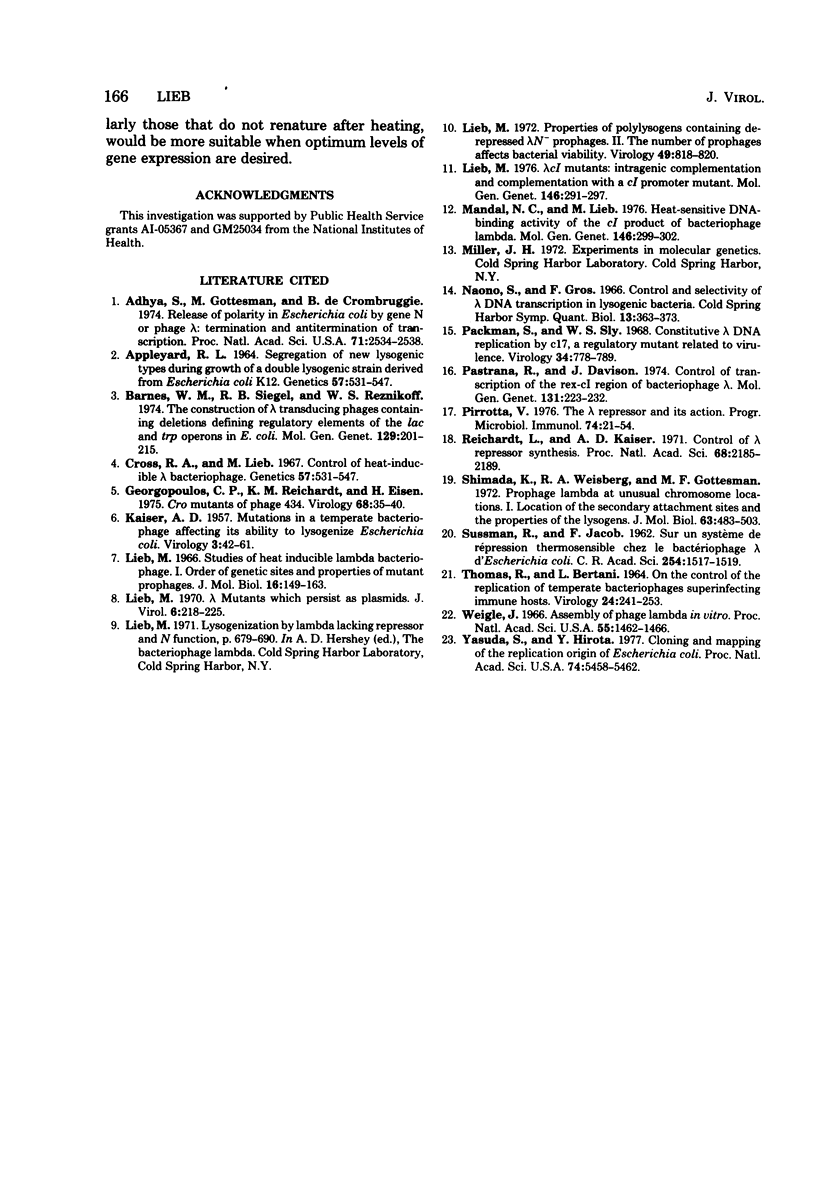Abstract
At 43 degrees C, lambda cIts prophages are "induced" and enter the lytic cycle. Lac- lysogens containing heat-inducible lambda N- prophages were superinfected with a lambda trp/lac N+cI- phage containing a lacZ+ gene whose expression is controlled by the lambda cI product (repressor). Lysogens were then heated, and the synthesis of beta-galactosidase and release of progeny phage were measured. In lambda N- cIts2 or lambda N-cIts16 lysogens superinfected with lambda trp/lac N+, beta-galactosidase appeared earlier and was synthesized more rapidly than in superinfected lysogens containing lambda N- cIts857 prophage. Even at 45 degrees C, the cI857 repressor retained some activity. Lysogens containing other N-cIts mutant prophages producing renaturable repressors were also only partially derepressed at 43 degrees C. Partial derepression of lambda "early" transcription is sufficient for induction of lambda N+ prophages.
Full text
PDF




Selected References
These references are in PubMed. This may not be the complete list of references from this article.
- Adhya S., Gottesman M., De Crombrugghe B. Release of polarity in Escherichia coli by gene N of phage lambda: termination and antitermination of transcription. Proc Natl Acad Sci U S A. 1974 Jun;71(6):2534–2538. doi: 10.1073/pnas.71.6.2534. [DOI] [PMC free article] [PubMed] [Google Scholar]
- Barnes W. M., Siegel R. B., Reznikoff W. S. The construction of lambda transducing phages containing deletions defining regulatory elements of the lac and trp operons in E. coli. Mol Gen Genet. 1974 Mar 27;129(3):201–215. doi: 10.1007/BF00267913. [DOI] [PubMed] [Google Scholar]
- Cross R. A., Lieb M. Control of heat-inducible lambda bacteriophage. Genetics. 1967 Nov;57(3):531–547. doi: 10.1093/genetics/57.3.531. [DOI] [PMC free article] [PubMed] [Google Scholar]
- Georgopoulos C. P., Reichardt K. M., Eisen H. Cro mutants of phage 434. Virology. 1975 Nov;68(1):35–40. doi: 10.1016/0042-6822(75)90145-2. [DOI] [PubMed] [Google Scholar]
- KAISER A. D. Mutations in a temperate bacteriophage affecting its ability to lysogenize Escherichia coli. Virology. 1957 Feb;3(1):42–61. doi: 10.1016/0042-6822(57)90022-3. [DOI] [PubMed] [Google Scholar]
- Lieb M. Lambda mutants which persist as plasmids. J Virol. 1970 Aug;6(2):218–225. doi: 10.1128/jvi.6.2.218-225.1970. [DOI] [PMC free article] [PubMed] [Google Scholar]
- Lieb M. LambdacI mutants: intragenic complementation and complementation with a cI promoter mutant. Mol Gen Genet. 1976 Aug 2;146(3):291–297. doi: 10.1007/BF00701253. [DOI] [PubMed] [Google Scholar]
- Lieb M. Properties of polylysogens containing depressed lambda N- prophages. II. The number of prophages affects bacterial viability. Virology. 1972 Sep;49(3):818–820. doi: 10.1016/0042-6822(72)90541-7. [DOI] [PubMed] [Google Scholar]
- Lieb M. Studies of heat-inducible lambda bacteriophage. I. Order of genetic sites and properties of mutant prophages. J Mol Biol. 1966 Mar;16(1):149–163. doi: 10.1016/s0022-2836(66)80269-3. [DOI] [PubMed] [Google Scholar]
- Mandal N. C., Lieb M. Heat-sensitive DNA-binding activity of the cI product of bacteriophage lambda. Mol Gen Genet. 1976 Aug 2;146(3):299–302. doi: 10.1007/BF00701254. [DOI] [PubMed] [Google Scholar]
- Naono S., Gros F. Control and selectivity of lambda DNA transcription in lysogenic bacteria. Cold Spring Harb Symp Quant Biol. 1966;31:363–375. doi: 10.1101/sqb.1966.031.01.047. [DOI] [PubMed] [Google Scholar]
- Packman S., Sly W. S. Constitutive lambda DNA replication by lambda-C17, a regulatory mutant related to virulence. Virology. 1968 Apr;34(4):778–789. doi: 10.1016/0042-6822(68)90099-8. [DOI] [PubMed] [Google Scholar]
- Pastrana R., Davison J. Control of transcription of the rex-cl region of bacteriophage lambda. Mol Gen Genet. 1974;131(3):223–232. doi: 10.1007/BF00267962. [DOI] [PubMed] [Google Scholar]
- Pirrotta V. The lambda repressor and its action. Curr Top Microbiol Immunol. 1976;74:21–54. doi: 10.1007/978-3-642-66336-9_2. [DOI] [PubMed] [Google Scholar]
- Reichardt L., Kaiser A. D. Control of lambda repressor synthesis. Proc Natl Acad Sci U S A. 1971 Sep;68(9):2185–2189. doi: 10.1073/pnas.68.9.2185. [DOI] [PMC free article] [PubMed] [Google Scholar]
- SUSSMAN R., JACOB F. [On a thermosensitive repression system in the Escherichia coli lambda bacteriophage]. C R Hebd Seances Acad Sci. 1962 Feb 19;254:1517–1519. [PubMed] [Google Scholar]
- Shimada K., Weisberg R. A., Gottesman M. E. Prophage lambda at unusual chromosomal locations. I. Location of the secondary attachment sites and the properties of the lysogens. J Mol Biol. 1972 Feb 14;63(3):483–503. doi: 10.1016/0022-2836(72)90443-3. [DOI] [PubMed] [Google Scholar]
- THOMAS R., BERTANI L. E. ON THE CONTROL OF THE REPLICATION OF TEMPERATE BACTERIOPHAGES SUPERINFECTING IMMUNE HOSTS. Virology. 1964 Nov;24:241–253. doi: 10.1016/0042-6822(64)90163-1. [DOI] [PubMed] [Google Scholar]
- Weigle J. Assembly of phage lambda in vitro. Proc Natl Acad Sci U S A. 1966 Jun;55(6):1462–1466. doi: 10.1073/pnas.55.6.1462. [DOI] [PMC free article] [PubMed] [Google Scholar]
- Yasuda S., Hirota Y. Cloning and mapping of the replication origin of Escherichia coli. Proc Natl Acad Sci U S A. 1977 Dec;74(12):5458–5462. doi: 10.1073/pnas.74.12.5458. [DOI] [PMC free article] [PubMed] [Google Scholar]


